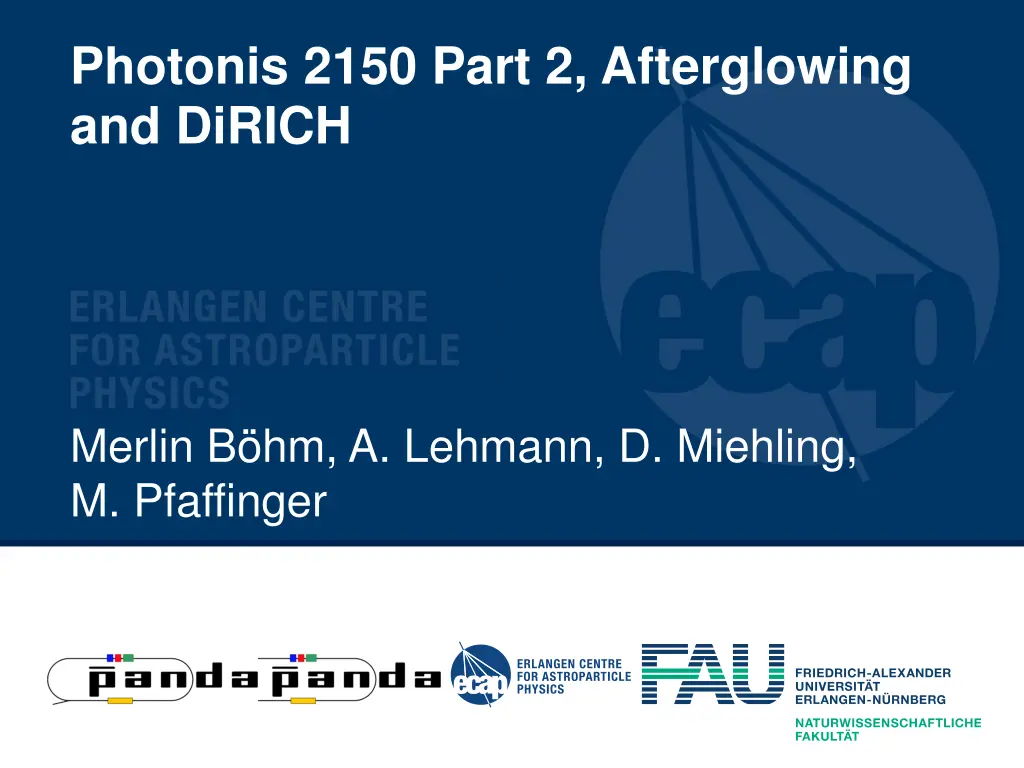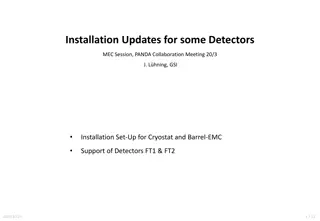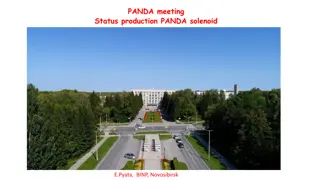
Advanced Photonis Sensor Measurements Analysis
Explore detailed measurements and analysis of Photonis 2150 sensor components, including afterglowing, dark count rates, afterpulse probabilities, time resolutions, crosstalk behavior, and countermeasures. The findings provide valuable insights for improved sensor performance and functionality in various applications.
Download Presentation

Please find below an Image/Link to download the presentation.
The content on the website is provided AS IS for your information and personal use only. It may not be sold, licensed, or shared on other websites without obtaining consent from the author. If you encounter any issues during the download, it is possible that the publisher has removed the file from their server.
You are allowed to download the files provided on this website for personal or commercial use, subject to the condition that they are used lawfully. All files are the property of their respective owners.
The content on the website is provided AS IS for your information and personal use only. It may not be sold, licensed, or shared on other websites without obtaining consent from the author.
E N D
Presentation Transcript
Photonis 2150 Part 2, Afterglowing and DiRICH Merlin B hm, A. Lehmann, D. Miehling, M. Pfaffinger
TRB measurements Time spectrum Sum of all events Laser pulse Afterpulses + Dark counts Dark counts Measured time delay between laser pulse and pixel response Panda Meeting 06 2019 Merlin B hm 2
TRB measurements Time spectrum zoomed Sum of all events Laser pulse Afterpulses + Dark counts Dark counts Measured time delay between laser pulse and pixel response Panda Meeting 06 2019 Merlin B hm 3
TRB measurements dark count rate Photonis 9002150 Threshold set to 0.1 p.e. (low noise background) at 2200V (0.7e6 gain) Whole Sensor 649 Hz, per Pixel average 10 Hz Panda Meeting 06 2019 Merlin B hm 4
TRB measurements Afterpulse probability Photonis 9002150 Threshold set to 0.1 p.e. (low noise background) at 2200V (0.7e6 gain) Whole sensor average afterpulse fraction 0.093% Panda Meeting 06 2019 Merlin B hm 5
TRB measurements RMS time resolution Photonis 9002150 Threshold set to 0.1 p.e. (low noise background) at 2200V (0.7e6 gain) Time window 90-110 ns Average time resolution of 280 ps dominated by readout electronics Panda Meeting 06 2019 Merlin B hm 6
TRB measurements Crosstalk 1 Hit 3 Hits 2 Hits Narrow time window of 1.5 ns, at 2200V (0.7e6 gain) 2 Pixels simultaneously hit reveals charge cloud width Charge cloud width ~1.6 mm FWHM 3 Pixels simultaneously hit reveals edge of pixels Panda Meeting 06 2019 Merlin B hm 7
TRB measurements Ringing behavior Monitoring the time over threshold (tot) during scans Adding 50 Ohm parallel between signal and ground in the past showed less ringing (or much higher frequency) and no multiple peaks in tot spectra Photonis countermeasure: adding 75 Ohm, is effective, too 2108 (no countermeasure) 2150 (75 Ohm on Backplane) Panda Meeting 06 2019 Merlin B hm Multiple peaks Continuous spectrum 8
TRB measurements Crosstalk behavior Adapter PCB MCP-PMT Cover half of the MCP-PMT and look at the number of simultaneous hits in a 15 ns window around the laser peak on the covered and open side at different thresholds Adjust ND-Filter to get ~1 p.e./Pixel ( ???) Adjust the voltage to get the same signal height distribution Discriminator boards (PADIWA) Panda Meeting 06 2019 Merlin B hm 9
TRB measurements Crosstalk behavior Reading out only the 3 most left and right rows so partially covered pixels don t distort the result On the covered half only crosstalk from oscillation should be seen Illuminated half: 18 pixels * (1-P(0)) = 12 hits expected (P(0) = exp(- ???) with ???= 1) On 2108 crosstalk events with up to 18 Hits/Laser pulse at low threshold can be observed, on 2150 only 2 hits Crosstalk signal height also 25% smaller on 2150 compared to 2108 Photonis countermeasures against crosstalk seem to be effective Panda Meeting 06 2019 Merlin B hm Open half Covered half 10
TRB measurements Crosstalk behavior 2150 open half 2108 open half Threshold Threshold Expected 12 Hits Expected 12 Hits 2150 covered half 2108 covered half Less fake hits at covered half of 2150 11 Number of Hits/Event Number of Hits/Event Panda Meeting 06 2019 Merlin B hm
New feature: afterglowing? After illuminating MCP-PMTs with high intensity light the darkcount rate is significantly increased The count rate decays within several seconds This effect can also be observed during our rate stability measurements: YH0245 Laser off Current [A] Laser on Time [s] Panda Meeting 06 2019 Merlin B hm 12
New feature: afterglowing? left: Photonis 9001393-URD right: Hamamatsu YH0250 red line corresponds to 2MHz photonrate per cm anode current in A anode current in A time in s time in s PANDA-Meeting 19/2 - June 25, 2019 Daniel Miehling 13
New feature: afterglowing? With current measurements: this feature seems to occur with both Photonis and Hamamatsu tubes and affects only ALD-tubes no effect: Photonis 9001341 (non-ALD tube) almost no or a small effect: Photonis 9001393 (two-ALD), 9001394 (ALD), 9002108 (ALD), 9002150 (ALD); Hamamatsu JS0026 (ALD?, Gie en), JS0035 (ALD) a strong effect: Hamamatsu YH0245 (ALD?, Gie en), YH0250 (ALD) PANDA-Meeting 19/2 - June 25, 2019 Daniel Miehling 14
New feature: afterglowing? comment: the summary on the last slide is preliminary since (most of) the data is from old ratestability measurements and only bycatch more investigations needed with both current measurements and PADIWA and/or DiRiCH PANDA-Meeting 19/2 - June 25, 2019 Daniel Miehling 15
Afterglowing further investigations with 9001393 with TRB Illuminating the full MCP- PMT PC for 5s with 1p.e./Pixel, then turn off the laser and measure the count rate Higher illumination intensity results in more afterglow Observed up to 10% afterglow events compared to the laser rate Panda Meeting 06 2019 Merlin B hm 16
Afterglowing further investigations with 9001393 with TRB Illuminating the full MCP- PMT PC for different amount of time with 1p.e./Pixel, then turn off the laser and measure the count rate Longer illumination intensity results in more afterglow Turning off the HV has no effect on the decay HV off Panda Meeting 06 2019 Merlin B hm 17
Afterglowing further investigations with 9001393 with TRB Illuminating the full MCP- PMT PC for 5s with 1p.e./Pixel and altered HV, then turn off the laser and measure the count rate Amount of afterglow is gain dependent Turning off the HV has no effect on the decay HV off Panda Meeting 06 2019 Merlin B hm 18
Afterglowing further investigations Further observations: Afterglowing must be an effect of the ALD-Layer because: Only MCP-PMTs with ALD-Layer affected No afterglow when turning on only the PC bias voltage on during illumination Higher MCP resistance leads to more afterglow Photonis as well as Hamamatsu MCP-PMTs are affected Panda Meeting 06 2019 Merlin B hm 19
Afterglowing further investigations Further observations: Afterglowing must be an effect of the ALD-Layer because: Only MCP-PMTs with ALD-Layer affected No afterglow when turning on only the PC bias voltage on during illumination Hamamatsu YH0250 Higher MCP resistance leads to more afterglow Photonis as well as Hamamatsu MCP-PMTs are affected Panda Meeting 06 2019 Merlin B hm 20
First DiRICH measurements Got a DiRICH system to test different input configurations of the DiRICH Time resolution measured with MCP-PMTs significantly better than Padiwa/TRB3 Photonis 2150 DiRICH 132 ps RMS Padiwa3 260 ps RMS Panda Meeting 06 2019 Merlin B hm 21
Summary Photonis 2150: Time resolution RMS of 171ps (scope) and ~279ps (PADIWA/TRB), but 132 ps with DiRich low darkcount rate and low afterpulse probability crosstalk behavior compared to 9002108 much better better ringing behaviour than former 9002108 tube MCP-PMT afterglowing after heavy illumination, is rate, duration, gain and MCP resistance dependent, investigation ongoing First DiRICH measurement very promising, but investigation ongoing Panda Meeting 06 2019 Merlin B hm 22





















